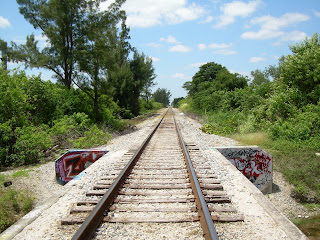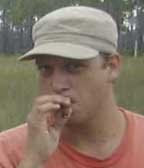
I've always loved trains. Not to play with, but to hear the thumping along the tracks, and not to mention that good old whistle ablowin'. They remind me of the past, which is silly, since they are still useful, and we could do with a bit more of them considering how inefficient transporting cargo in motor vehicles is. But I digress, I am here to talk about the plant jewels of the tracks.
Last summer, I dropped my car off at the shop, about 4 miles from the house (my hobo life is occurs in my interests). The car shop is along some railroad tracks that run close to my house, so I decided to hike back home along them. I've always wanted to walk the lines, as I suspected much could be learned from these now "ancient" corridors, now reserved for the uncommon train that passes along them. So off I went.
The beginning of the journey was great. Being August, sweat was really pouring off of my brow, and the air was thick and heady. The first plant species were of less interest to me, being common weedy exotics, but even they have their stories, which I'll save for later.
Now remember, plants are everywhere (just about), and not all plants are, or continue to be useful. Conservationists tend to separate those species that are native, which do little harm to the environment they're a part of, from those species which have been introduced by people and cause havoc in our natural areas.
Don't get me wrong, all plants have uses. After all, one of the definitions of a weed is "a plant whose use has not been discovered" (and I'll add "or no longer utilized"). Today, as a people, few of us grow or harvest plants for direct personal need. Our energy and food come from elsewhere by and large. So these poor non-native (or exotic) plants fill up spaces being unutilized. As a result, they crowd out existing native plant species, and all other creatures that use them. This can happen in our natural areas, but often happens in empty unmanaged lots and remnant natural fragments, such as these along the railroad tracks.
Walking from railroad timber to railroad timber, the scene began to change. Remnant habitat popped up, and I saw what I knew to occur there, pine rockland species. (Railroad 2 of 5)
Last summer, I dropped my car off at the shop, about 4 miles from the house (my hobo life is occurs in my interests). The car shop is along some railroad tracks that run close to my house, so I decided to hike back home along them. I've always wanted to walk the lines, as I suspected much could be learned from these now "ancient" corridors, now reserved for the uncommon train that passes along them. So off I went.
The beginning of the journey was great. Being August, sweat was really pouring off of my brow, and the air was thick and heady. The first plant species were of less interest to me, being common weedy exotics, but even they have their stories, which I'll save for later.
Now remember, plants are everywhere (just about), and not all plants are, or continue to be useful. Conservationists tend to separate those species that are native, which do little harm to the environment they're a part of, from those species which have been introduced by people and cause havoc in our natural areas.
Don't get me wrong, all plants have uses. After all, one of the definitions of a weed is "a plant whose use has not been discovered" (and I'll add "or no longer utilized"). Today, as a people, few of us grow or harvest plants for direct personal need. Our energy and food come from elsewhere by and large. So these poor non-native (or exotic) plants fill up spaces being unutilized. As a result, they crowd out existing native plant species, and all other creatures that use them. This can happen in our natural areas, but often happens in empty unmanaged lots and remnant natural fragments, such as these along the railroad tracks.
Walking from railroad timber to railroad timber, the scene began to change. Remnant habitat popped up, and I saw what I knew to occur there, pine rockland species. (Railroad 2 of 5)


No comments:
Post a Comment